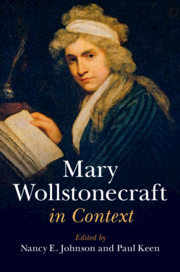Book contents
- Mary Wollstonecraft in Context
- Mary Wollstonecraft in Context
- Copyright page
- Contents
- Illustrations
- Notes on Contributors
- Preface
- Frontispiece
- Chronology
- Part I Life and Works
- Part II Critical Fortunes
- Part III Historical and Cultural Contexts
- The French Revolution Debate
- Chapter 9 Writing the French Revolution
- Chapter 10 Radical Societies
- Chapter 11 Radical Publishers
- Chapter 12 British Conservatism
- The Rights of Woman Debate
- Philosophical Frameworks
- Legal and Social Culture
- Literature
- Suggested Further Reading
- Index
Chapter 12 - British Conservatism
from The French Revolution Debate
Published online by Cambridge University Press: 16 January 2020
- Mary Wollstonecraft in Context
- Mary Wollstonecraft in Context
- Copyright page
- Contents
- Illustrations
- Notes on Contributors
- Preface
- Frontispiece
- Chronology
- Part I Life and Works
- Part II Critical Fortunes
- Part III Historical and Cultural Contexts
- The French Revolution Debate
- Chapter 9 Writing the French Revolution
- Chapter 10 Radical Societies
- Chapter 11 Radical Publishers
- Chapter 12 British Conservatism
- The Rights of Woman Debate
- Philosophical Frameworks
- Legal and Social Culture
- Literature
- Suggested Further Reading
- Index
Summary
For Mary Wollstonecraft, the numerous cultural and political debates that constituted the public life of British citizens in the final years of the eighteenth century boiled down to some fundamental choices. As she put it in her discussion of Rousseau (a philosopher whose blend of republicanism and misogyny made him an important part of her thinking about the rights and wrongs of her age), “Rousseau exerts himself to prove that all was right originally; a crowd of authors that all is now right; and I, that all will be right.”1 Conservative thinkers would never have endorsed Rousseau’s primitivism, which provided a rationale for wholesale revolution against the ills of modern civilization, and they would likely have considered it a stretch to say that all was right in contemporary Britain. From the age of Pope and Swift onwards, conservative thinkers tended to align themselves with a vision of decline that had been hastened by the effeminizing influence of Britain’s consumer revolution. But in the deeply polarized climate of the 1790s, and in the face of growing demands for radical democratic reform from an extended public that had never before presumed to participate in the political process, the present (or at least the pre-1789 version of it) was looking good.
- Type
- Chapter
- Information
- Mary Wollstonecraft in Context , pp. 102 - 108Publisher: Cambridge University PressPrint publication year: 2020



